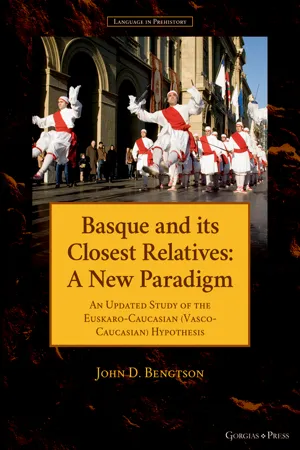
- 546 pages
- English
- PDF
- Available on iOS & Android
About This Book
This book is a comprehensive and detailed treatment of the Euskaro-Caucasian hypothesis – the proposal that the Basque language is most closely related to the North Caucasian language family. A more or less similar hypothesis was developed in the twentieth century by prominent scholars, including C.C. Uhlenbeck, Georges Dumézil, and René Lafon. The efforts of these savants, and others, while important, were rather sporadic and consisted of scattered articles, and they never developed a comprehensive phonological and morphological model of Euskaro-Caucasian. Their work on the hypothesis ceased with the death of the last of them, Dumézil, in 1986. On the other hand, thanks to advances in our understanding of Basque phonology and etymology, and in North Caucasian phonology and etymology, and improved linguistic methods, it has become possible to develop a comprehensive Euskaro-Caucasian phonological structure, including regular sound correspondences of vowels and consonants supported by significant numbers of etymologies. These correspondences, in turn, have allowed the author to evaluate objectively the etymological proposals of earlier investigators (which led to the modification or outright rejection of many of them), and have also provided clues to discovering some original etymologies. The nucleus of the Euskaro-Caucasian hypothesis is "old, " beginning in the nineteenth century, but the "new paradigm" alluded to in the provisional title refers to (a) a focus on the North Caucasian language family as the closest surviving relative of Basque (as opposed to the "South Caucasian" = Kartvelian family), (b) a new and comprehensive scheme of comparative phonology, (c) new discoveries in comparative morphology, and (d) several hundred lexical and grammatical etymologies that supersede the more haphazard comparisons offered in earlier works.
Frequently asked questions
Information
Table of contents
- Table of Contents
- ACKNOWLEDGMENTS
- Foreword
- INTRODUCTION
- I. Exercise 1: An Experiment in Classification (Taxonomy)
- II. Exercise 2: A Different Approach
- III. Dialects of Basque
- IV. Basque Phonology in Euskaro-Caucasian Perspective
- V. Basque Morphology in Euskaro-Caucasian Perspective
- VI. North Caucasian Phonology in Euskaro-Caucasian Perspective
- VII. Euskaro-Caucasian Comparative Phonology I: Introduction
- VIII. Euskaro-Caucasian Comparative Phonology II: Vowels
- IX. Euskaro-Caucasian Comparative Phonology III: Consonants
- X. Euskaro-Caucasian Comparative Phonology IV: “Irregular” Phonetic Changes: Metathesis, Haplology, Assimilation, Dissimilation, Expressive Forms, Contamination and Blending
- XI. Euskaro-Caucasian Comparative Phonology V: Some Special Etymological Problems
- XII. Euskaro-Caucasian Etymologies: Introduction
- XIII. Euskaro-Caucasian Etymologies A: Anatomical Terms
- XIV. Euskaro-Caucasian: Genetic Linguistics, Archaeology, and Human Genetics
- Abbreviations
- References
- Guide to Phonetic Transcriptions
- Appendix A: Rosters of the most historically stable lexicon
- Appendix B: The Position of Kartvelian
- Appendix C: A Discussion of the Lexicostatistical Study by Tovar, et al. (1961)
- Index I: Basque to English
- Index II: English (semantic)
- About the Author